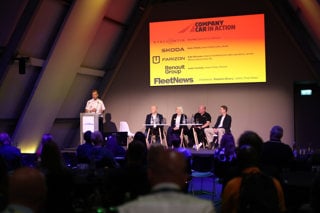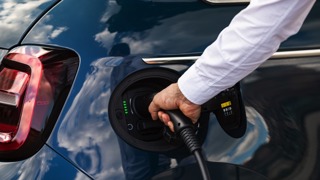Martin Wedge, managing director of OVL Group discusses the highly-charged subject of alternative fuel.
They have been around for a number of years, but never really seen as a real fleet option until the climate changed – literally and financially - and manufacturers started pushing the cost and green credentials of electric and hybrid vehicles to the business community. So what do fleet managers and drivers looking for a change need to know now to help them make the right choice?
First of all what are they? Well, they are two distinct entities; the full electric has zero-emissions at the point of use, requires an external electrical supply to charge it and has no internal combustion engine. The first thing to remember here is that electric drive is not a source of per se, but just a transmission method which requires a power source elsewhere (electricity grid, or another generation source; solar, wind, tidal).
The current crop of these vehicles includes the game-leader the Nissan Leaf, two offerings from Renault, the zany Twizy and the more conventional Zoe, the Peugeot iOn, the VW e-up, Citroen Czero, Ford Focus Electric, Mitsubishi i-MiEV,and from BMW, the i3. So, not a huge choice, particularly as quite a few of these are actually re-badged versions of the same car! Possibly not in the fleet budget are the exotics like the Tesla S, and a whole raft of experimental and concept vehicles just for fun.
The next step on is the “range-extender” which is really a ‘hybrid-hybrid’, if such a thing exists. These have a small on-board internal combustion (IC) engine to charge the battery when it reaches a pre-set discharge level thus extending the vehicle’s range. BMW has a range-extender version of the i3, and the other examples of this system are; Vauxhall Ampera and Chevrolet Volt (same car, different badge), and the Mazda2 EV with a rotary engine generator.
A full hybrid is really an electric transmission with a battery back-up. A full size IC engine will kick in to propel the vehicle if the battery power is not enough to meet the needs of the users right foot, or to top up the battery while in cruise. The Toyota Prius and Lexus RX450h were the early examples of this technology and more are on the way. Some of the later versions of these are also eligible for the Plug-in grant. Not many, just four; Mitsubishi Outlander PHEV, Toyota Prius Plug-in Hybrid, Volvo V60 and Porsche Panamera S E-Hybrid.
There is nothing new about hybrid drive systems. Railway locomotives have been hybrids for years, the Napier Deltic Diesel had an electric transmission back in 1962 and the HS125s are still in use with a gas turbine hybrid electric drive. The smart bits these days are the batteries with far higher power density (more power stored in a less heavy battery) and the clever software to blend the power together with the IC power in a user friendly way so we can easily use it on an everyday basis to get around.
The big advances at the moment are in battery chemistry. Lead acid is too big and heavy to be realistic any more, and lithium ion, lithium air and soon lithium sulphur, are seen as the way forward. With power densities around triple that of lead acid (3 times as much power stored in a battery of the same weight and/or size). This development has been driven by the mobile phone and handheld computer market where increasingly power hungry devices are being designed and need feeding! Battery manufacturers are looking forward to a big pay-day when electric vehicles become the norm.
By the end of this year it is expected that the majority of motorway service stations will have a rapid charger that can charge up an electric car in less than 30 minutes, just enough time to get a burger and a coffee! That charge could cost around £3, but for now it is free, and gets drivers about 100 miles – so equates to 3p per mile. Less if you charge at home at a slower rate overnight, maybe down to 2p per mile. However, a word of warning: charging from your own domestic supply does not have the advantage right now of being for free. There are deals around to get a free 3kw charging station unit installed at your home or a 7kw version for a small extra charge. The deal is that you agree to allow the unit to monitor your use of it by GPRS data supplied to a government research body. This is in part grant funded to the installer.
However, it is not as straight forward as plug and drive. There are some issues surrounding the use of 13 amp domestic plug in as the current draw is high and long term and may cause overheating of your house wiring. Having a professionally installed charging unit overcomes any of those problems. Cost per full charge £2, and 100 miles range. It is estimated that there are already around 5000 public access charge points and that number is growing all the time with main rail stations and many employee car parks getting equipped so you can get charged while you work.
Cost per mile of a full hybrid can vary enormously depending on the amount of use you make of the on board engine as opposed to the battery/electric motor option. The vehicles tend to be much larger so the cost is going to be higher because of that, and, if you go over 100 miles per charge, it will be running mostly on whichever fossil fuel the car’s IC prefers and not as efficiently as a well driven diesel or petrol car. This is because transmission losses are higher than a mechanical gearbox.
The best thing about an electric transmission or hybrid drive system is that electric motors have a flat torque curve whih means they can deliver maximum torque from stationary and have no need for a clutch. IC engines each have one speed where they will perform best with regard to torque, fuel efficiency and emissions, so the combination of an IC engine running at its favourite speed and an electric transmission which is happy at any speed is a winner. The only down side is the conversion, or transmission, losses which average 10% each time.
What really matters is cost per mile and this will have a great deal to do with driver behaviour. Acceleration sucks up power way more than cruise speed.
However, current Government incentives include a £5000 pound purchase price discount on a qualifying car (built in to a contract hire monthly cost) or up to £8000 on a van, zero road fund licence, zero London congestion charge, and the free charge cost at public charging points for now.
Apart from that diesel engined cars can get at best around 15p per mile, petrol a bit worse, so the claimed costs of 2p or 3p per mile are very convincing. Of course that all goes out the window once your IC engine fires up in your hybrid and you are back to the 15p per mile rate.






















bennyjoseph - 20/11/2014 05:16
The electric cars are indeed making an good alternative to fuel ones but is becoming unaffordable to many and in contrary the fuel ones are quite cheaper.